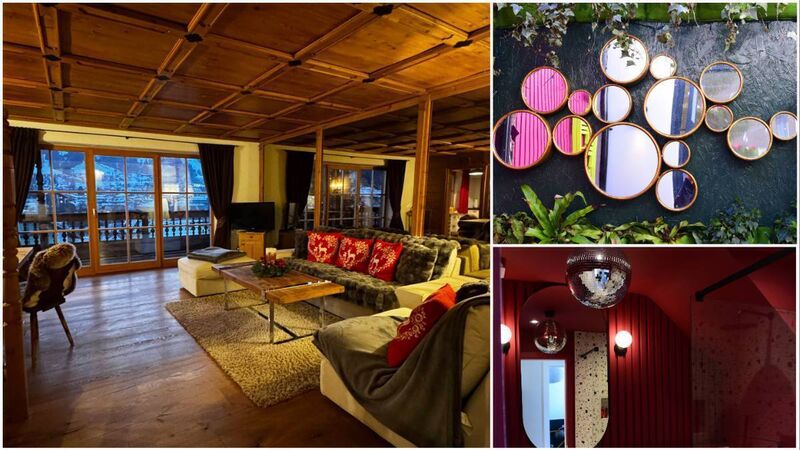'I live in a tiny house. Here's how I use mirrors to expand space'

Left, a fully mirrored wall; top right, mirrors in Jennifer Sheahan's garden, below right, a glitterball and mirror in Jennifer Sheahan's downstairs bathroom.
If I had to pick one answer to the most frequent questions I receive, it would be mirrors. How do I brighten up my dark room? Mirrors. How do I make my small space feel bigger? Mirrors. How do I add depth and interest to my interior design without breaking the bank? Win the lotto (just kidding — it’s mirrors).
When it comes to mirrors, more is more. Yet most of us are still thinking about mirrors in the most basic way — a bathroom mirror here, maybe a hallway mirror there. We're missing a trick.
I often feel a slight hesitation when I suggest mirrors to clients. I believe there are three reasons for this. Mainly, it is because as a nation, we have a collective terror of appearing vain. It’s also partly due to the fact that mirrors don’t tend to photograph well, and so we lack inspirational images to stimulate our imaginations.
Finally, it’s partly due to a fear of going too far and ending up with tacky Celtic Tiger decor. Forget vanity — mirrors done well blend into the background, and anyway, what’s wrong with checking yourself out every now and then? Avoiding the tacky look is easy as long as you choose clean lines and avoid gaudy bevels and frames.
With that, here are some easy and cost-effective ways to transform your home with the power of mirrors.
If you’re dealing with a room that’s short on natural light, placing a mirror directly opposite a window can work wonders. This trick effectively “doubles” your window, bouncing light back into the room and creating more outdoor views. The key here is to make sure the mirror reflects something pleasant, such as leafy greenery or blue (OK, grey) skies.
If you have a small living room or dining room, consider cladding an entire wall with a mirror. I know this sounds drastic, but having a frameless wall-to-wall mirror actually makes it blend more seamlessly into the room, and you can tone it down even further by using tinted glass.

Putting a reflective surface behind your furniture or shelving blurs the visual boundaries and hugely enhances the sense of space in your room, as well as increasing light.
In narrow hallways, try placing a full-length mirror on the wall opposite a window (a transom or fanlight over your door is perfect) to draw light down the space. Alternatively, a long horizontal mirror along an adjacent wall will widen the space.
Aside from increasing light and sense of space, strategic placement of mirrors can be used to create all sorts of visual tricks that will enhance your home. Placing a mirror in the corner of a room, angled to reflect the longest sightline, can make any space appear significantly larger. This works particularly well in bedrooms where you want to create a sense of spaciousness without placing the mirror directly facing the bed. It also works great in any boringly square room to break up the boxy lines.

While it’s tempting to hang every mirror flat against the wall, consider angling them for maximum effect. Tilting a mirror slightly upward (by simply leaning it against the wall, for example) can elongate the reflection and create the illusion of height.
We tend to think of mirrors as vertical elements, but placing them horizontally (i.e. on a flat surface) can be transformative. Try a mirrored tray or runner as part of a tablescape to bounce candlelight around the room. Just don’t put them on your ceiling, this isn’t the Moulin Rouge.
If your home is lacking period features or interesting architectural details, guess what can help with that? Arched mirrors mimic the shape of windows or doorways, suggesting more space and structure.
A pair of tall, slim mirrors flanking a doorway can act like faux windows, lending symmetry and width to an otherwise flat wall. You can also add mirrors above doorways to mimic transom windows, which will add height and light to your room.

A wonderful place to try these illusions is in your garden, especially if you have a small one. Adding mirrors that are designed to look like windows or doorways to your garden wall can transform your cramped courtyard space into an expansive Narnia.
I absolutely love a tinted mirror backsplash in a kitchen, big or small, and I feel it’s often ignored as an option. It is a brilliant, simple, cost-effective way to make your kitchen feel spacious, bright, and interesting. The argument I often hear is “won’t it get dirty?”, to which I say every backsplash will get dirty, but a smooth flat surface is easy to wipe clean, far easier than grout, plus a smoked or tinted mirror is much more forgiving.

I prefer one custom-sized seamless mirror, which does come with a price tag, especially when you add in cut-outs for sockets and switches, but even still, this will be less expensive than premium stone or designer tiles.
Mirrors — especially mirrored backsplashes — don’t tend to photograph well, so I implore you to visit some kitchen showrooms to see for yourself. Avoid the faux-antiqued effect in favour of a cleaner, tinted mirror for a cleaner and more sophisticated look.
The biggest mistake I see people making with mirrors is going too small. A tiny mirror on a big wall looks lost and doesn't achieve any of the space-enhancing benefits we're after. Bigger is better here. A good rule of thumb is to take up at least 70% of the available space with a mirror, and don’t be afraid to take up the whole wall.

Another common error is placing mirrors where they'll reflect something unattractive, like the bins or a cluttered corner. Always check what your mirror will show before you hang it. The reflection should show off the best of your home, not highlight its messy areas.
Finally, when shopping, don’t waste money on fancy frames that you don’t need. Mirrors do not need to be expensive.
A simple, sleek black or brass frame is elegant and contemporary, or if you really want the mirror to disappear, go frameless for a minimalist look that blends seamlessly into your wall. If you want to spend money, consider spending it on custom mirrors cut to fit your space.










